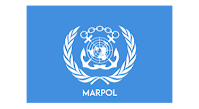History of MARPOL:
- The International Convention for the Prevention of Pollution from Ships (MARPOL) is the main international convention covering the prevention of Pollution of the marine environment by ships from operational or accidental causes.
- In the year 1954 first conference was held relating to Sea Pollution known as "The International Convention for the Prevention of Pollution of the Sea by Oil (OILPOL)".
- This conference was first organised by the United Kingdom and laterally the regulations and functions related to the Conventions were transferred to IMO.
- In 1967, a disastrous accident of the Oil Tanker Torrey Canyon happened which dumped almost 120,000 tonnes of oil into the English Channel, the 1954 convention was modified and the MARPOL Convention was adopted on 2 November 1973 at IMO.
- The Protocol of 1978 was adopted in response to a spate of tanker accidents in 1976-1977.
- As the 1973 Convention had not yet entered into force, the 1978 MARPOL Protocol absorbed the parent Convention.
- The combined instrument entered into force on 2 October 1983 and is called MARPOL 73/78.
- In 1997, a protocol was adopted to amend the Convention and a new Annex VI was added which entered into force on 19 May 2005.
- MARPOL has been updated by amendments through the years.
- The Conventions include the regulations aimed at preventing and minimizing pollution from ships - both accidental pollution and that from routine operations. Currently, MARPOL includes six Annexes.
- Special areas with strict controls on operational discharges are included in most Annexes.
Annexes Under MARPOL 73/78:
Annex I: Regulations for the Prevention of Pollution by Oil
- It entered into force on 2 October 1983.
- It covers the prevention of pollution from Oil from operational measures as well as from accidental discharges.
- The 1992 amendments to Annex I made it mandatory for new oil tankers to have Double Hulls and brought in a phase-in schedule for existing tankers to fit double hulls, which was subsequently revised in 2001 and 2003.
Annex II: Regulations for the Control of Pollution by Noxious Liquid Substances in Bulk
- It entered into force on 2 October 1983.
- It covers the details of discharge criteria and measures for pollution control by Noxious Liquid Substances carried in bulk.
- A list of 250 substances was evaluated and appended to the Convention, the discharge of their residue is allowed only to the reception facilities until certain concentrations and conditions are complied with.
Annex III: Regulations for the Prevention of Pollution by Harmful Substances carried by Sea in Packaged Form
- It entered into force on 1 July 1992.
- It contains general requirements for issuing detailed standards on packing, marking, labelling, documentation, stowage, quantity limitations, exceptions, and notifications.
- For the purpose of this Annex "Harmful Substances" are those substances that are identified as marine pollutants in the International Maritime Dangerous Goods (IMDG) Code.
Annex IV: Regulations for the Prevention of Pollution by Sewage from Ships
- It entered into force on 27 September 2003.
- It contains the general requirement for the control of pollution of the Sea by Sewage.
- It covers the discharge standards and the use of approved Sewage Treatment Plant
Annex V: Regulations for the Prevention of Pollution by Garbage from Ships
- It entered into force on 31 December 1988.
- It deals with different types of garbage and specifies the proper method of disposal.
- The most important feature of this Annex is the complete ban imposed on the disposal of Plastics into the Sea.
- It covers the implementation of the Garbage Management Plan and Garbage record book
Annex VI: Regulations for the Prevention of Air Pollution from Ships
- It entered into force on 19 May 2005
- It sets the limit on SOx and NOx emissions from ships exhaust and prohibits the emissions on Ozone Depleting Substances.
- A chapter adopted in 2011 covers the mandatory technical and operational energy efficiency measures aimed at reducing Greenhouse gas emissions from the ship.
- It covers the collection and reporting of Ships Fuel Oil Consumption data and promotion of technical co-operation and transfer of technology relating to the improvement of energy efficiency of Ships
Reference: www.imo.org







0 Comments
Thanks for your Valuable comments and Suggestions